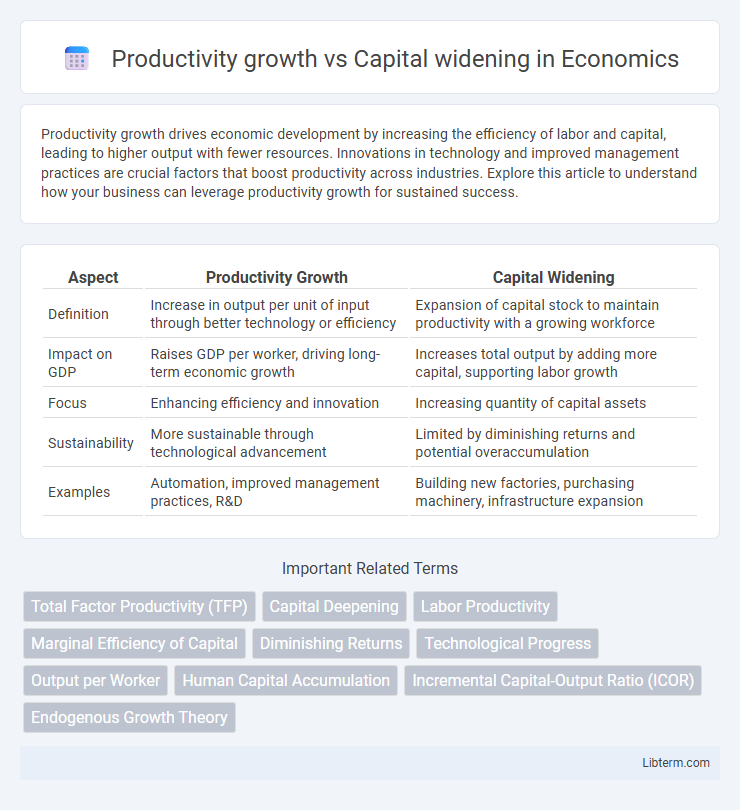Productivity growth drives economic development by increasing the efficiency of labor and capital, leading to higher output with fewer resources. Innovations in technology and improved management practices are crucial factors that boost productivity across industries. Explore this article to understand how your business can leverage productivity growth for sustained success.
Table of Comparison
| Aspect | Productivity Growth | Capital Widening |
|---|---|---|
| Definition | Increase in output per unit of input through better technology or efficiency | Expansion of capital stock to maintain productivity with a growing workforce |
| Impact on GDP | Raises GDP per worker, driving long-term economic growth | Increases total output by adding more capital, supporting labor growth |
| Focus | Enhancing efficiency and innovation | Increasing quantity of capital assets |
| Sustainability | More sustainable through technological advancement | Limited by diminishing returns and potential overaccumulation |
| Examples | Automation, improved management practices, R&D | Building new factories, purchasing machinery, infrastructure expansion |
Overview of Productivity Growth and Capital Widening
Productivity growth measures the increase in output per unit of input, highlighting efficiency improvements in labor and technology over time. Capital widening refers to the expansion of capital assets, such as machinery and infrastructure, to maintain or increase production capacity alongside a growing workforce. Both concepts are crucial for economic growth, with productivity growth driving higher output without necessarily increasing inputs, while capital widening ensures sufficient resources are available to support larger scale operations.
Defining Productivity Growth: Key Concepts
Productivity growth measures the increase in output per unit of input, reflecting improvements in efficiency and technology within an economy. It contrasts with capital widening, which expands total capital without changing productivity per unit, often by increasing workforce size or machinery proportionally. Key concepts include total factor productivity, labor productivity, and technological innovation as drivers of genuine productivity growth beyond mere capital accumulation.
Understanding Capital Widening: An Introduction
Capital widening refers to increasing the quantity of capital stock to equip a growing labor force, ensuring that capital per worker remains constant without necessarily improving productivity. It contrasts with productivity growth, which involves enhancing the efficiency and output per unit of input through technological advancements or better organizational methods. Understanding capital widening is crucial for distinguishing between growth driven by expanding resources versus growth driven by improved productivity.
Core Differences Between Productivity Growth and Capital Widening
Productivity growth measures how efficiently labor and capital are used to increase output per unit of input, reflecting improvements in technology, skills, and processes. Capital widening involves increasing the quantity of inputs, such as machinery or labor, to expand production capacity without necessarily improving efficiency. The core difference lies in productivity growth enhancing output through better utilization of existing resources, while capital widening expands output by adding more resources.
Drivers of Productivity Growth in Modern Economies
Productivity growth in modern economies primarily stems from technological innovation, human capital development, and improvements in organizational efficiency, which enhance output per unit of input. Unlike capital widening that increases total capital stock to boost production scale, productivity growth improves the effective use of existing resources. Key drivers include research and development investments, advanced education systems, and digital transformation that foster higher labor and capital productivity.
The Role of Capital Widening in Economic Expansion
Capital widening plays a crucial role in economic expansion by increasing the overall stock of capital available for production without necessarily improving the efficiency of existing assets, thus enabling higher output levels through scalability. It supports growth by accommodating labor force increases and allowing businesses to expand their physical infrastructure such as machinery, buildings, and technology. This expansion amplifies production capacity but differs from productivity growth, which enhances output per unit of input by improving technology or processes.
Advantages and Limitations of Productivity Growth
Productivity growth increases output per unit of input, boosting economic efficiency and long-term sustainable development by fostering innovation and technological advancements. It enables higher wages and improved living standards without proportionally increasing resource consumption or environmental impact. However, productivity growth can face limitations such as diminishing returns, skill mismatches in the labor market, and the need for continuous investment in education and technology to maintain momentum.
Economic Impacts of Capital Widening: Benefits and Drawbacks
Capital widening refers to increasing the quantity of capital per worker, boosting overall production capacity and potentially raising short-term output and employment rates. This approach enhances economic growth by enabling more extensive utilization of labor and resources but may lead to diminishing returns if capital accumulation outpaces improvements in technology or productivity. While capital widening stimulates expansion through investment, its drawbacks include potential inefficiencies, increased depreciation costs, and limited long-term growth without concurrent productivity advancements.
Policy Strategies: Enhancing Productivity vs. Encouraging Capital Widening
Policy strategies for enhancing productivity emphasize investments in technology, workforce skills, and innovation capacity to drive sustained economic growth and efficiency gains. Encouraging capital widening focuses on expanding physical capital stock, such as infrastructure and machinery, to increase production capacity but may face diminishing returns without simultaneous productivity improvements. Optimal economic development policies balance both approaches by promoting human capital development and technological advancement alongside targeted capital accumulation.
Future Outlook: Balancing Productivity Growth and Capital Widening
Future economic expansion depends on balancing productivity growth with capital widening, where productivity growth enhances output per labor hour through innovation and efficiency improvements, while capital widening increases total capital stock to support a larger workforce. Investment in advanced technologies, such as automation and AI, drives productivity gains, but sustained growth also requires expanding infrastructure and human capital to absorb new investments. Strategic policies fostering both technological adoption and capital accumulation are essential to achieving long-term, inclusive growth and resilience in evolving global markets.
Productivity growth Infographic

 libterm.com
libterm.com